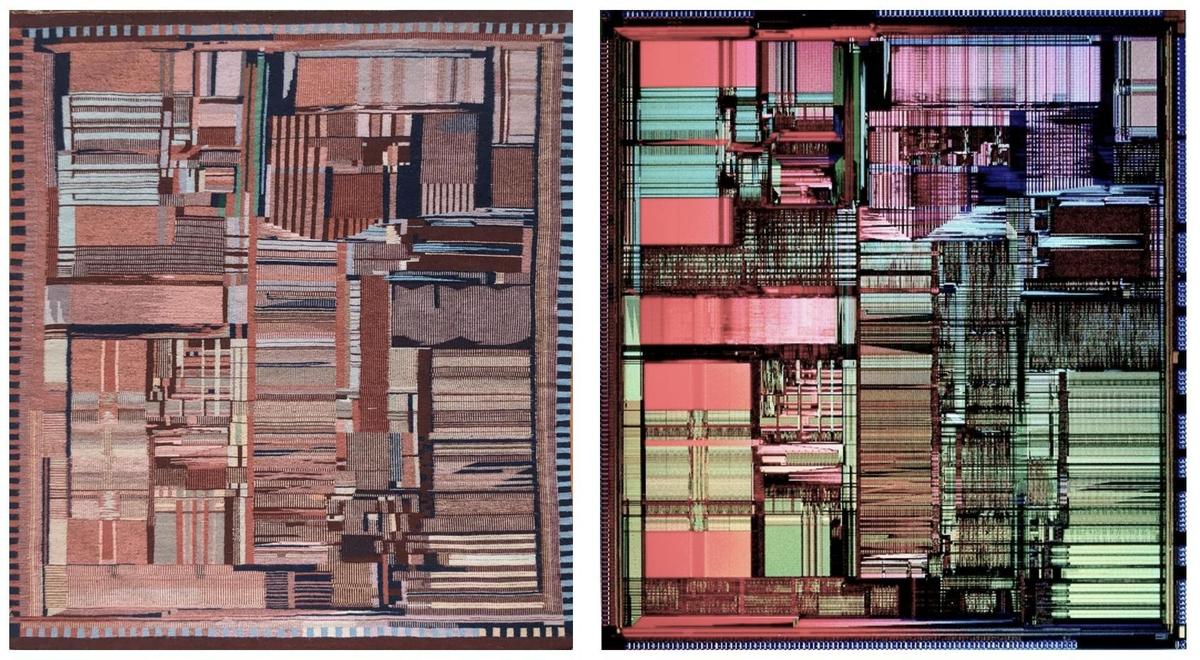
This article's headline shows two images side-by-side with one another. On the right is an image of Intel's first-ever Pentium processor die, released in 1993. To its left is an image of the same processor, woven into a rug in the traditional Navajo style. The stunning likeness and intense craftsmanship behind the rug caught the eye of reverse engineer Ken Shirriff, who dug into the history of the piece and its significance.

"Replica of a Chip" was woven by Marilou Schultz in 1994, and was recently displayed in the National Gallery of Art in Washington, D.C. The wool weaving was commissioned from Schultz by Intel in the same year, presented as a gift to the American Indian Science & Engineering Society (AISES). Schultz, a Navajo/Dine' weaver, wove the piece in the traditional technique. Navajo-Churro sheep's wool was spun into yarn, thinner than is traditional to obtain the fine detail of the die. As a result of the high complexity of the rug as well as the finer yarn, progress on the piece was only around an inch of length per day.
"The weaving is a remarkably accurate representation of the die, reproducing the processor's complex designs," observes Shirriff. "[It] is accurate enough that each region can be marked with its corresponding function in the real chip." While the colors are not as vibrant as the chip die breakdowns we are used to seeing, those who know the Pentium architecture will be able to identify its parts. Shirriff's blog post contains a detailed overlay of the chip floorplan. The weaving's shockingly accurate floating-point unit block in the bottom right region and 32-bit integer execution units running down the center are of particular note.
The Pentium the rug is modeled after is a specific Pentium variant called the P54C, an improved refresh of the Pentium which made the chip smaller to avoid running hot and slow. The "multiprocessor logic" block, present in the P54C and not the original P5, is how Shirriff correctly ID'd the rug.
Intel's connection to New Mexico and the Navajo reservation officially begins in 1980, where the company's Albuquerque fab produced 70% of Intel profits. But the company's past also involves the Navajo reservation, which some argue was exploited by the chip industry in the 1960s. Fairchild Semiconductor's Shiprock, New Mexico fab was opened in the 1960s for the economic development of the Navajo reservation, where weavers were employed to work on integrated circuits like the Fairchild 9040 (this IC is the subject of Schultz's current weaving project). While viewed as a success by Fairchild VP Robert Noyce (who went on to found Intel), the plant was eventually shut down due to an armed takeover by disgruntled Navajo tribe members after rolling layoffs.
Intel's original Pentium processor was a major milestone for the semiconductor industry, and the "Replica of a Chip" rug commemorates it in expert three-dimensional weaving. For more on the details of the rug, the history of the Pentium, and the Fairchild Navajo plant, read Ken Shirriff's original blog post here. Those interested in seeing the weaving in person will be out of luck; the exhibition it inhabited was closed by the National Gallery on July 28th.







